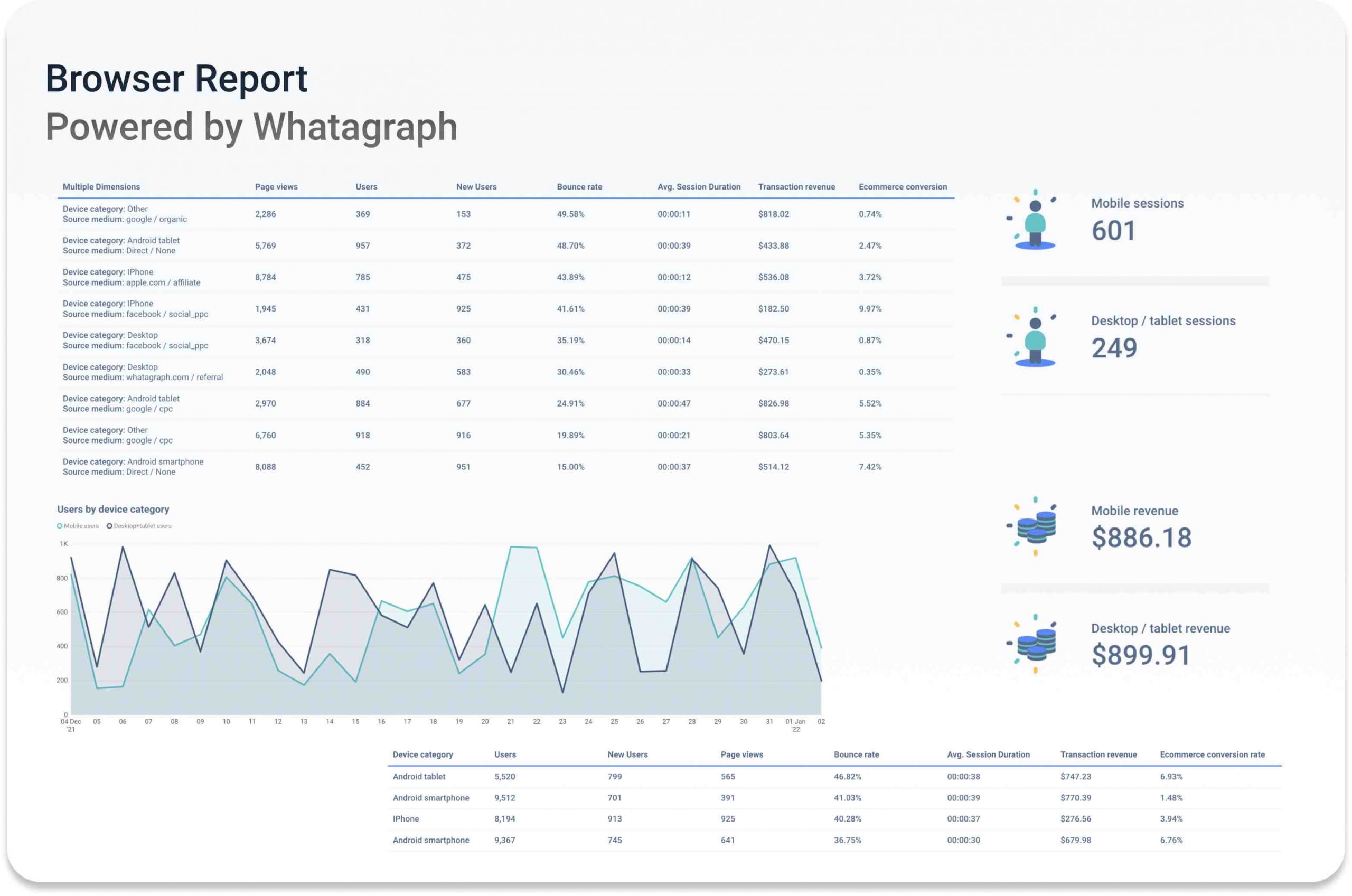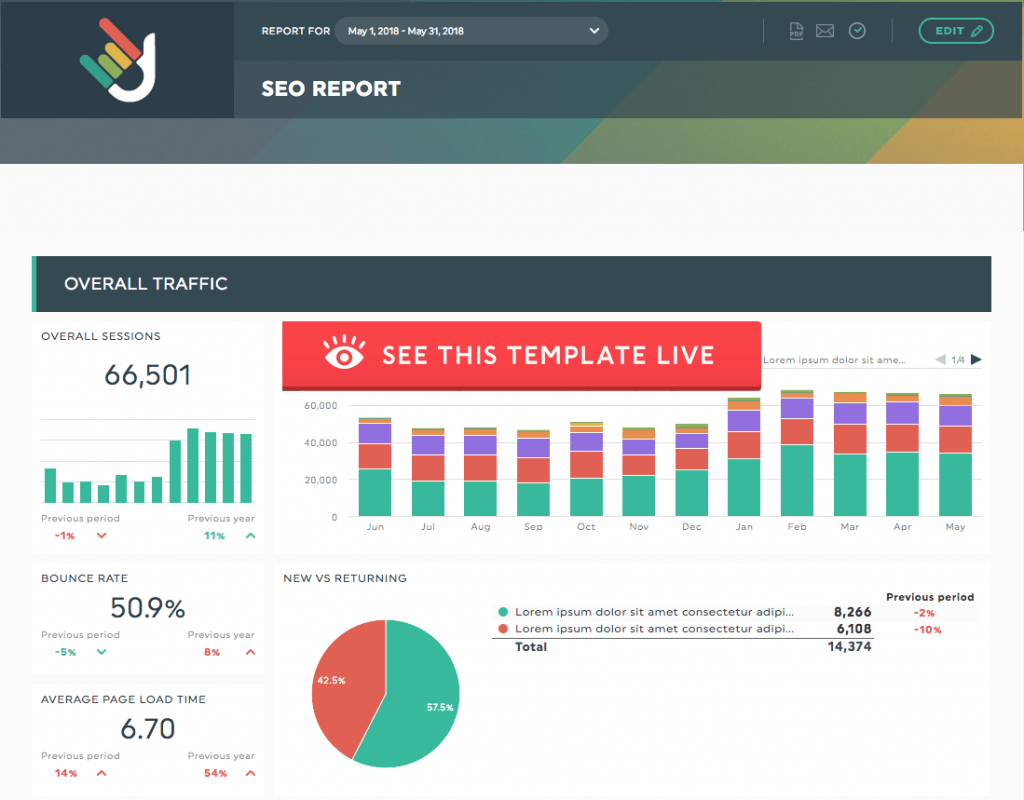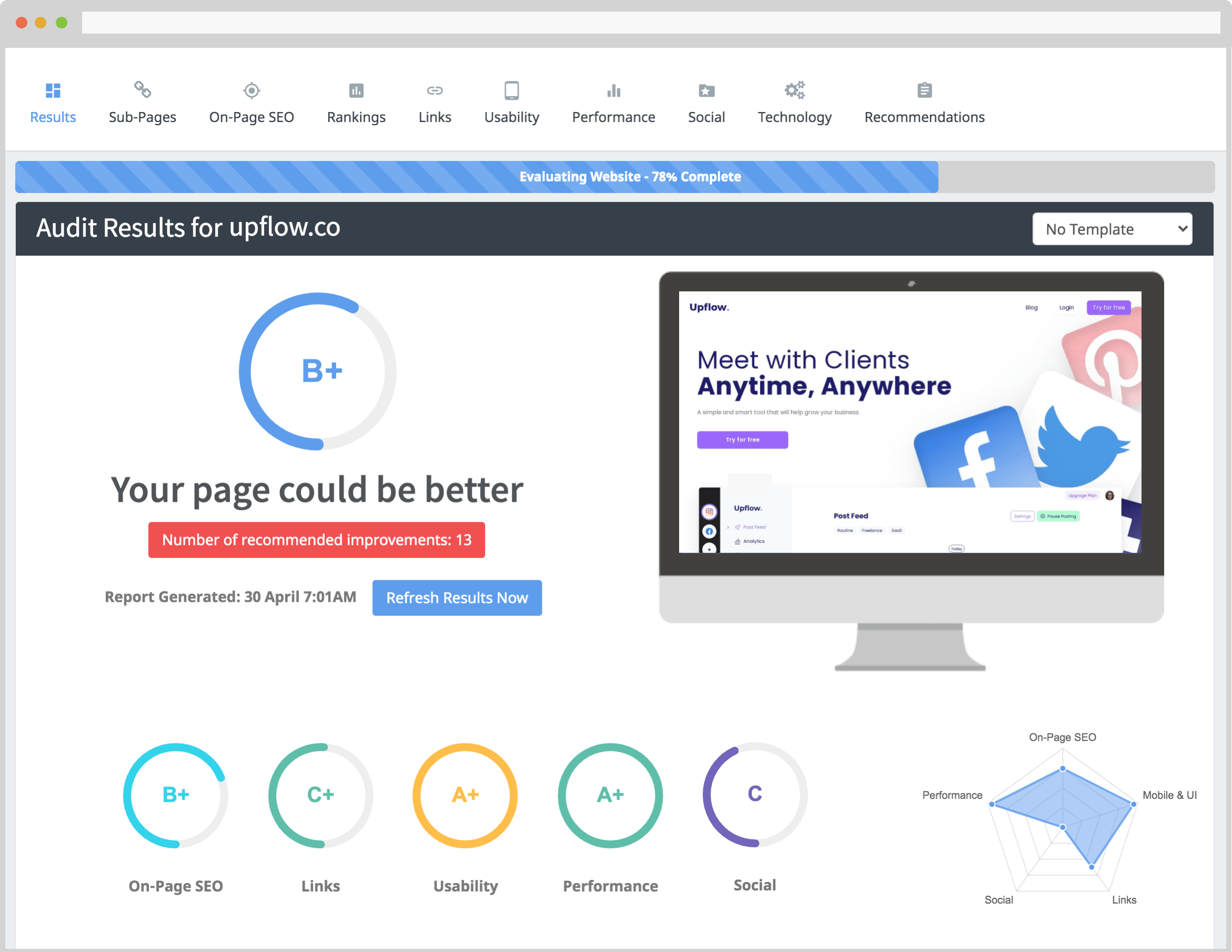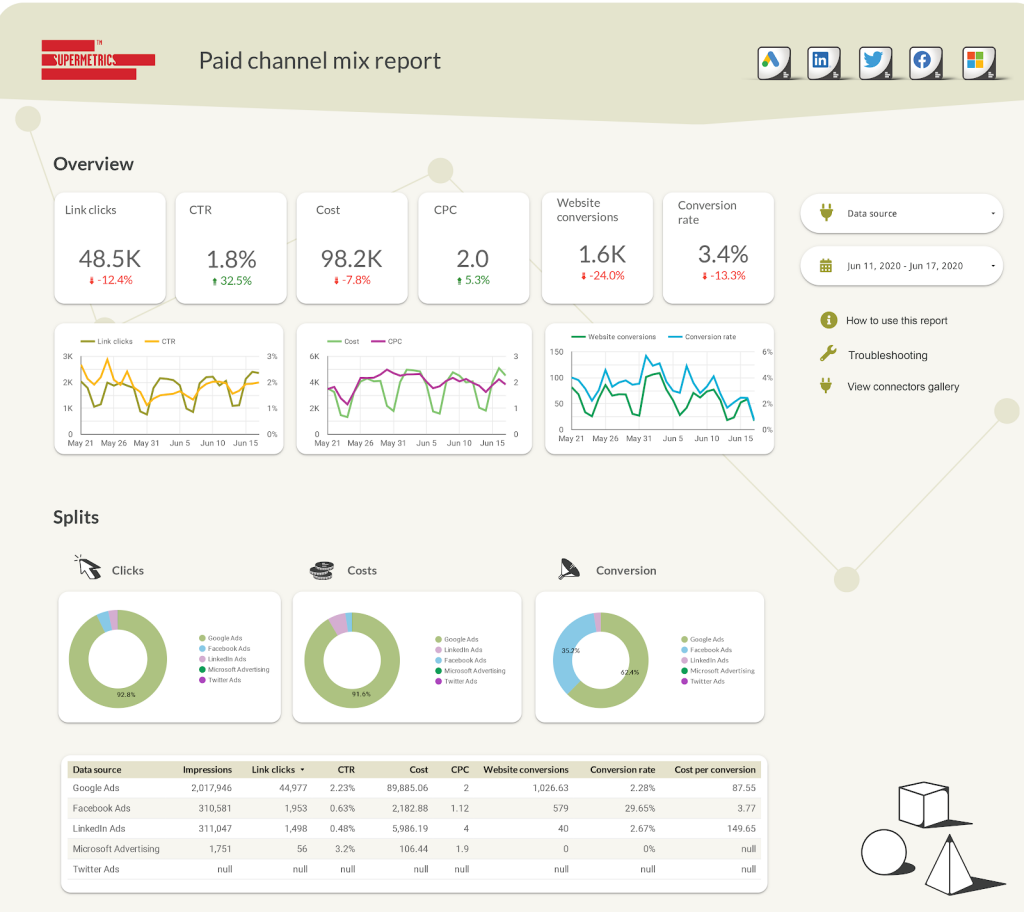If you manage SEO for clients, you know the importance of delivering accurate and insightful reports. You’ve done the job, now you have to show it.
Your customers rely on you to give them the relevant information they need to make informed decisions about their marketing efforts going forward. The SEO report is their (and your) roadmap.
To get it right every time, it’s a matter of creating a system that you can replicate consistently for each customer.
So, what does it take to create perfect SEO reports? These are the seven essential elements.
1. Traffic: Sources

Is increasing organic traffic to their website your client’s main goal? Start your SEO reports with traffic.
If you’re using Google Analytics, you’ll also want to use the Source/Medium section of the traffic report for this part of the report. It gives you more information about where your visitors are coming from, so that your customer can determine where to spend their time and money.
Make sure to include mobile sources in this section of the report as well, as mobile phones accounted for approximately 63% of organic search engine visits in 2021.
This part of the report will look something like the image below. To get there quickly, go to Acquisition > All Traffic > channels.
Screenshot of Google Analytics, July 2022
2. Conversion Rate & Progress On Goals

Huge streams of site traffic are great, but if you don’t know what your visitors want or how they want to engage with your content, even all the traffic in the world won’t get you very far.
In other words, if you can’t convert your visitors into customers, no amount of traffic will help you.
Conversion rate is probably one of the most important KPIs (Key Performance Indicators) for your customers, so put it at the front of your report for easy access.
Once you’ve discovered the conversion rate, you’ll be in a better position to explain what comes next in the report and describe why they’re seeing certain insights and data points.
To demonstrate conversion rate to a customer, select certain goals that you want to track as “conversions.”
In this example, a nonprofit customer used landings on their “Thank you for the donation!” page to track completed donations.
Google Analytics counts each landing as a donation, helping to achieve the goals in the “Goal Completion” section.
Go to Conversions > to go to Goal Completion. Goals > Overview.
Screenshot of Google Analytics, July 2022
3. Top Performing Pages
You probably know where your visitors are coming from, but it’s vital to know where they’re going on your site.
If someone lands on your site organically through Google, that’s great; However, knowing that they clicked on your most recent blog post is much more valuable.
You always want to include the best performing pages so your customer knows what works and what doesn’t. There are usually lessons they can learn from pages that are doing well and apply them to pages that can use help to attract (and retain) traffic.
One way to pull data from Google Analytics to illustrate this is through the Landing Pages section.
To get there, first go to Behavior, then Site Content and Landing Pages. You will see which URLs are hot and which are not quite.
4. Page Speed Insights

For this part, take a short break from Google Analytics and head to a tool called Google’s PageSpeed Insights. It’s a completely free tool that shows your customers how fast their pages load and what performance issues they can fix to improve their results.
Sometimes it’s something as small as a video with too large a file size. This simple quick fix will get your pages up and running quickly.
Page speed hasn’t always been a high priority, but as users’ expectations become more and more demanding with their online experiences, it’s paramount that your pages load quickly to keep visitors on your site.
In fact, Google tells us that going from one second to three seconds increases the chance of someone bouncing off a website by 32%.
Screenshot from PageSpeed Insights, July 2022
5. Bounce Rate And Dwell Time

Knowing that visitors have come to your site, clicked on certain pages, and in some cases converted is incredibly helpful.
But to get the full picture, your customer needs to know how long people stay on their site and how many of them click away after the first landing page.
Dwell time is the time someone spends on a web page when they come from an organic search. Do they explore other pages from there or are they looking for a quick answer?
However, a high bounce rate is not always a bad thing.
If their landing page was chock-full of internal links to other pages on your site and they bounced quickly, it probably means they’ve moved on to exploring these outbound links.
In this section, focus on bounce rate for content-rich core site pages such as videos. They should stay for a while to consume the content.
6. Rankings And Backlinks
Backlinks can be powerful tools for websites struggling to progress in their SEO rankings.
You can find many tools to track links you have, which is useful as it can identify potential SEO opportunities.
If you’ve helped your client gain backlinks as part of your SEO strategy, demonstrate their impact in this section of the report.
In terms of rankings, you should include where the site ranks for keywords that you’ve determined to be the most valuable to the customer.
Keep in mind that rankings are no longer the ultimate goal of SEO – we now know that countless factors, such as history, user geographic location and personalization, can all affect rankings.
7. Recommendations And Next Steps
Recommendations may not be the first thing that comes to mind under a mountain of data, but recommendations and next steps are ultimately what the customer is looking for at the end of this report.
Your next steps and recommendations will use all the data you’ve collected and apply it to future strategy so that there’s an actionable plan for improving the shortcomings and maximizing success.
A Final Note
The best way to show your progress through your SEO reports is to compare results from previous reporting periods.
Choose the frequency that works for you and your customer – quarter after quarter, year after year, etc. – and use it consistently to show growth.
Combine all these aspects and you get the perfect SEO report every time.
Featured Image: fizkes/Shutterstock
How do I create SEO tools for my website?
How to create an on-page site audit tool?
- Find Broken Links.
- Check for missing or incorrect robots. text.
- Discover missing or incorrect sitemap.
- Check for internal linking problems.
- Detect missing meta description tag.
- Find incorrect use of header tags (eg H1).
- Discover duplicate content.
- Generate a sitemap.
Which is the one of the SEO audit tools?
Overview: SEOmator is one of the most powerful technical SEO auditing tools available on the market today. While most digital marketing professionals use up to four different marketing tools to monitor their SEO performance, SEOmator promises to deliver technical, on-page, and off-page SEO audits in a single platform.
Is an example of an SEO audit tool? Moz Crawl Test is another synonym for SEO and website audit. Moz has its own website crawler that helps webmasters identify critical website issues, HTTP status codes, and other useful SEO data for website audit.
Which is a free SEO audit tool?
SEOptimer is a free SEO audit tool that performs detailed SEO analysis on 100 website data points and provides clear and actionable recommendations on steps you can take to improve your online presence and ultimately rank better in search engine results.
What should be in an SEO report?
An SEO report is a summary of SEO metrics that illustrate how your site is performing. Reports typically cover areas such as overall organic traffic, conversions, backlinks, and website technical health. However, you can customize the report to suit your goals.
What is an SEO Analysis Report? Search engine optimization (SEO) analysis is the practice of checking a website to identify opportunities to improve its placement in search engine results. A related goal is not only to improve search engine rankings (SERP), but also to boost actual organic referral traffic from those search results.
What are the 4 main components of an SEO?
Each component builds on and complements the others. The stronger the connections between each of the 4 SEO components – technical SEO, on-page SEO, off-page SEO and content – the better the results. Being aware of the connections will help us better understand how to best use them.
Does SEO need to be done monthly?
The truth is, you don’t have to pay an agency for a monthly SEO campaign. And as a director of an agency, many of you will be shocked to hear this. SEO is not rocket science.
Does SEO need to be maintained? You will always have to work to maintain your rankings, which is where SEO maintenance becomes useful. With SEO maintenance as a core part of your SEO strategy, you can drive down your competitors. You can refresh content, for example update keyword targeting, fix broken links and more.
Why is SEO monthly?
SEO takes time to affect your site’s performance and you won’t see changes overnight. A monthly commission for your SEO company gives them time to develop the best campaign for your business with no time constraints. Plus, with a monthly SEO subscription, you can build a relationship with your SEO company.
How often should SEO be done?
Frequency of new visits According to Jonny Ross Consultancy and other industry experts, it is recommended that you review your keyword strategy quarterly and at least 3 to 6 months before a campaign or promotion.

